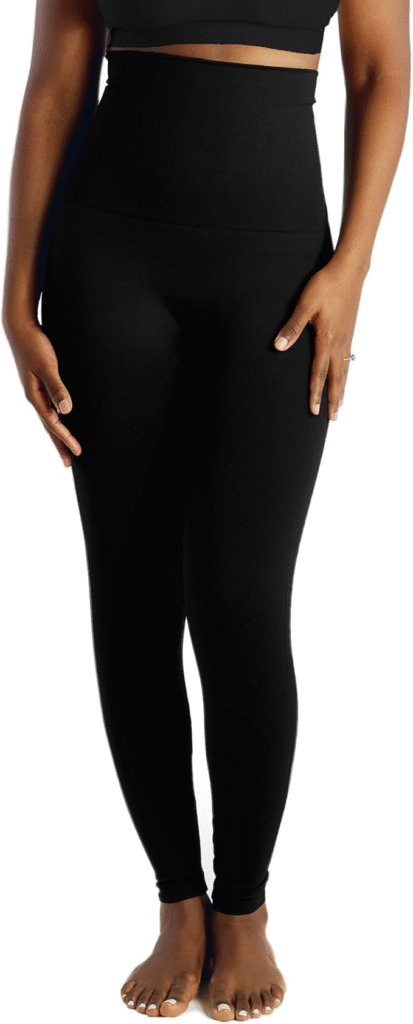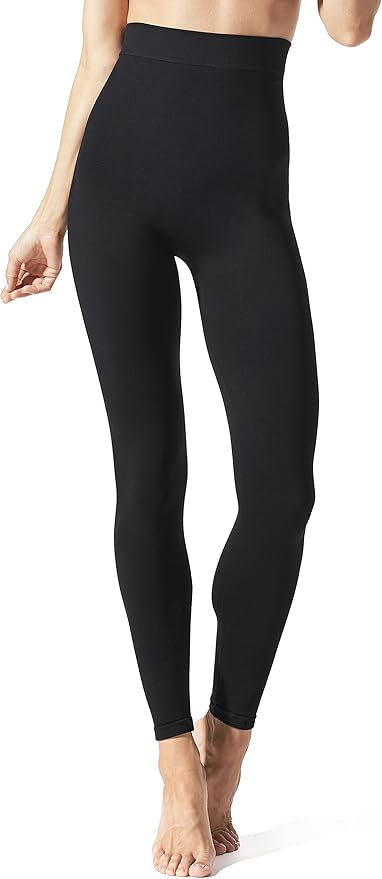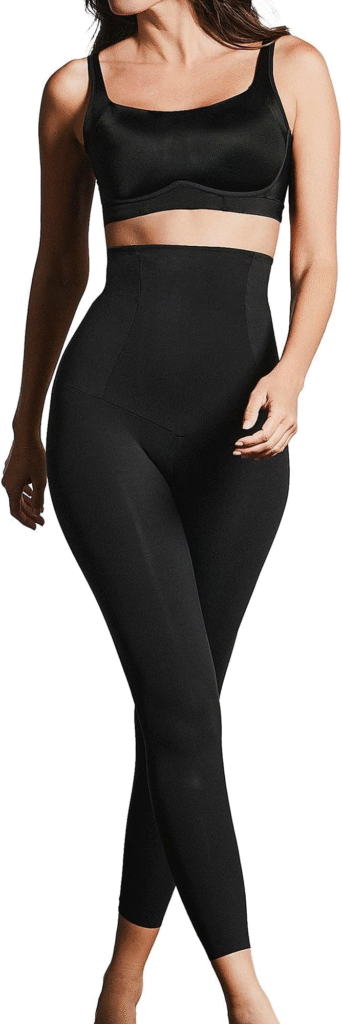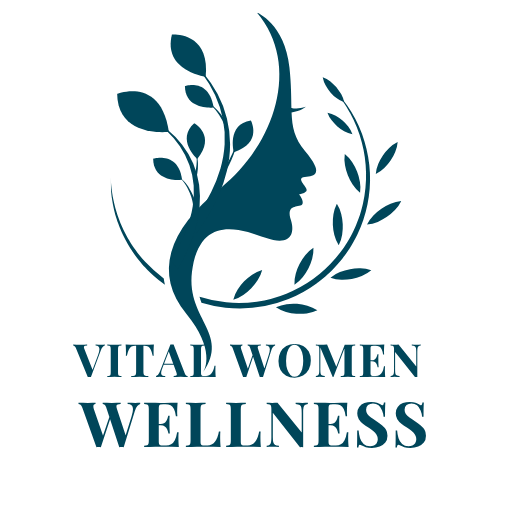Understanding Postpartum Recovery and Compression Wear
The postpartum period marks a significant phase of physical and emotional changes for new mothers. Your body works tirelessly to heal and gradually return to its pre-pregnancy state.
During this time, compression wear, particularly leggings, can play a crucial role in supporting your recovery process.
Compression leggings function by applying gentle, consistent pressure to your abdomen, hips, and legs. This pressure serves multiple purposes:
- It helps reduce swelling, a common postpartum issue.
- It improves blood circulation, aiding in overall healing.
- It provides much-needed support to your core muscles, which have been stretched and weakened during pregnancy.
For mothers who have undergone a C-section, these leggings offer an additional benefit of protecting and comforting the incision area.
Benefits of Compression Leggings for New Moms
1. Abdominal Support
After childbirth, your abdominal muscles are in a weakened state because of the stretching they’ve endured during pregnancy. Compression leggings provide gentle yet firm support to these muscles, assisting them in regaining their strength and tone.
This support is particularly useful when you’re carrying your baby or performing daily tasks that engage your core.
2. Reduced Swelling
Postpartum swelling, medically known as edema, is a common occurrence, especially in the legs and feet. The graduated compression feature in these leggings applies more pressure at the ankles and gradually decreases up the leg.
This design effectively improves circulation and helps reduce fluid retention, providing relief from swollen extremities.
3. Improved Posture
The support provided by compression leggings extends beyond just the abdominal area. By offering support to your core and lower back, these leggings can significantly improve your posture.
This benefit is particularly valuable during the postpartum period when you’re likely to spend long hours nursing or carrying your baby, which can strain your back and lead to poor posture.
4. C-Section Recovery
For mothers who have undergone a cesarean section, compression leggings can be a game-changer in the recovery process. These leggings offer protection to the incision site, reducing the risk of irritation from clothing or accidental bumps.
Additionally, they provide support during movement, which can help reduce discomfort and promote healing.
5. Confidence Boost
The postpartum period can be challenging for many women as they adjust to the changes in their bodies. Compression leggings can help smooth your silhouette, providing a more contoured appearance.
This subtle shaping effect can give you a much-needed confidence boost during a time when you might be feeling self-conscious about your changing body.
Choosing the Right Compression Leggings
Selecting the ideal pair of compression leggings for your postpartum recovery needs careful consideration of several factors:
1. Compression Level
The level of compression is a crucial factor to consider. Look for leggings with graduated compression, which means they’re tighter at the ankles and gradually become less tight as they go up the leg.
This design promotes better blood flow back to the heart, reducing swelling and fatigue in your legs.
Different brands may offer varying levels of compression, typically measured in mmHg (millimeters of mercury). For postpartum recovery, a moderate compression level between 15-20 mmHg is generally suitable.
However, it’s always best to talk to your healthcare provider to decide the most appropriate compression level for your specific needs.
2. Material
The fabric of your compression leggings plays a significant role in your comfort, especially considering you might be wearing them for extended periods. Opt for breathable, moisture-wicking materials that will keep you cool and dry throughout the day.
Some popular fabric choices include:
- Nylon blends: These offer excellent stretch and recovery, maintaining the compression effect over time.
- Polyester blends: Known for their moisture-wicking properties, these keep you dry and comfortable.
- Spandex or elastane: These materials provide the necessary stretch and flexibility.
Some leggings also incorporate antimicrobial properties, which can be particularly useful during postpartum recovery when maintaining hygiene is crucial.
3. Waistband
The waistband of your compression leggings is a key feature to consider, especially for postpartum recovery. Look for leggings with a high, wide waistband that can provide extra abdominal support.
This design helps to smooth your midsection and offer additional compression to your core area.
Some leggings feature a double-layered waistband for enhanced support and shaping. Others may have an adjustable waistband, allowing you to customize the fit as your body changes during recovery.
4. Ease of Use
As a new mom, convenience is key. Consider leggings with features that make your daily routine easier, such as:
- Easy-access panels for nursing or pumping
- Moisture-wicking gussets for added comfort
- Pockets for storing small essentials like your phone or keys
These thoughtful design elements can make a significant difference in your day-to-day comfort and convenience.
5. Size and Fit
Proper sizing is crucial for compression wear to be effective. Many brands offer sizing guides specifically for postpartum bodies, taking into account the unique changes your body undergoes after childbirth.
When measuring yourself for compression leggings, consider:
- Your current waist and hip measurements
- The level of compression you need
- Your height (some brands offer different length options)
Remember that compression leggings should feel snug but not uncomfortably tight. If you’re between sizes, it’s generally better to size up to ensure comfort and avoid restricting circulation.
Top Picks for Postpartum Compression Leggings
1. Belly Bandit Mother Tucker Compression Leggings
These leggings are a popular choice among new mothers because of their targeted compression design. They offer firm support to your core, helping to improve posture and reduce back pain. The high waistband provides excellent coverage and support for your abdomen, making them ideal for both C-section and vaginal delivery recovery.
Key features:
- Seamless design for a smooth silhouette
- Moisture-wicking fabric for all-day comfort
- Available in multiple sizes to ensure a perfect fit

2. Blanqi Everyday Highwaist Postpartum + Nursing Support Leggings
Designed specifically for postpartum recovery, these leggings feature built-in support for your belly and lower back. They’re also suitable for nursing, with no-show nursing support that allows for discreet and comfortable breastfeeding.
Key features:
- Breathable, moisture-wicking fabric
- Seamless design to prevent chafing
- Built-in belly support panel

3. Leonisa Postpartum High-Waisted Compression Leggings
These leggings offer firm compression and feature a special panel to support your abdomen and help reduce the appearance of a post-baby belly. They’re made with a comfortable, breathable fabric that’s perfect for all-day wear.
Key features:
- PowerSlim® fabric for firm compression
- High-waisted design for most coverage
- Available in multiple colors

4. Homma High Waist Compression Leggings for Women Tummy Control Postpartum Leggings
While not specifically designed for postpartum wear, these affordable leggings offer good compression and tummy control, making them a popular choice among new moms. They’re made with a thick, opaque fabric that provides excellent coverage.
Key features:
- High waistband for tummy control
- Four-way stretch fabric for comfort and flexibility
- Available in a wide range of colors

How to Use Compression Leggings Safely
While compression leggings can offer many benefits during postpartum recovery, it’s crucial to use them safely:
1. Consult Your Healthcare Provider
Before incorporating compression leggings into your postpartum recovery routine, always talk to your healthcare provider. This is particularly important if you’ve had a C-section or experienced any complications during childbirth.
Your doctor can advise on when it’s safe to start wearing compression garments and recommend the appropriate level of compression for your specific needs.
2. Gradually Increase Wear Time
When you first start using compression leggings, it’s best to ease into it. Begin by wearing them for short periods, perhaps 2-3 hours at a time.
As you become more comfortable and your body adjusts, you can gradually increase the duration.
Pay attention to how your body feels and don’t push yourself to wear them for extended periods if you’re experiencing discomfort.
3. Listen to Your Body
Your comfort and well-being should always be the priority. If you experience any pain, discomfort, or unusual symptoms while wearing compression leggings, remove them immediately and talk to your healthcare provider.
Signs to watch out for include:
- Numbness or tingling in your legs or feet
- Increased pain or discomfort around your C-section incision (if applicable)
- Difficulty breathing or feeling overly constricted
- Skin irritation or rashes
4. Maintain Proper Hygiene
Good hygiene is crucial when using compression garments, especially during postpartum recovery when your body is healing. Follow these tips to keep your leggings clean and hygienic:
- Wash your leggings after each use, following the care instructions on the label.
- Use a gentle, fragrance-free detergent to avoid skin irritation.
- Allow your leggings to air dry completely before wearing them again.
- Have multiple pairs on hand so you can rotate them, ensuring you always have a clean pair available.
5. Don’t Rely Solely on Compression Wear
While compression leggings can be a valuable tool in your postpartum recovery, they shouldn’t be your only focus. Combine their use with other important aspects of postpartum care, such as:
- Gentle exercises approved by your healthcare provider
- A balanced, nutritious diet to support healing
- Adequate rest and sleep
- Proper hydration
- Regular check-ups with your healthcare provider
Beyond Leggings: Other Postpartum Compression Options
While compression leggings are a popular choice for postpartum recovery, there are other compression wear options that can complement your recovery process:
1. Compression Shorts
Compression shorts can be an excellent choice to leggings, especially in warmer weather or when you prefer to wear dresses or skirts. They typically extend from the waist to mid-thigh, providing targeted support to your abdomen and upper legs.
Benefits of compression shorts include:
- Improved blood circulation in the pelvic area
- Support for the lower abdominal muscles
- Reduced chafing and irritation in the thigh area
2. Belly Bands
Belly bands, also known as abdominal binders, are designed to provide focused support to your abdomen and lower back. They’re typically worn around the midsection and can be adjusted for a custom fit.
Key benefits of belly bands:
- Targeted support for weakened abdominal muscles
- Assistance in improving posture
- Potential relief from lower back pain
3. Full-Body Shapewear
For comprehensive support from bust to thigh, full-body shapewear can be an effective option. These garments often mix the benefits of a supportive bra, abdominal compression, and leg support in one piece.
Advantages of full-body shapewear:
- All-in-one solution for full-body support
- Smooth silhouette under clothing
- Often designed with easy-access features for nursing
Incorporating Compression Wear into Your Postpartum Routine
Compression leggings and other compression garments are valuable tools in your postpartum recovery toolkit. To maximize their benefits, consider the following tips for incorporating them into your daily routine:
1. Start with Short Wear Times
Begin by wearing your compression leggings for short periods, such as 2-3 hours at a time. This allows your body to adjust to the compression and helps you gauge your comfort level.
2. Gradually Increase Duration
As you become more comfortable, slowly increase the amount of time you wear your compression leggings. Many women find they can comfortably wear them for most of the day after a few weeks of adjustment.
3. Combine with Gentle Movement
Wear your compression leggings during light activities approved by your healthcare provider. This might include short walks, gentle stretches, or postpartum-specific exercises.
The combination of compression and movement can enhance circulation and support your recovery.
4. Use During Breastfeeding Sessions
If you’re breastfeeding, consider wearing your compression leggings during feeding sessions. The abdominal support can help you maintain better posture, potentially reducing back strain during long nursing periods.
5. Alternate with Other Recovery Methods
While compression wear can be useful, it’s important to give your body breaks. Alternate between wearing compression leggings and using other recovery methods, such as gentle massage or warm compresses on your abdomen.
6. Adjust as Your Body Changes
Your postpartum body will continue to change in the weeks and months following childbirth. Regularly reassess the fit and comfort of your compression leggings, and be prepared to adjust your size or style as needed.
7. Listen to Your Body’s Cues
Pay attention to how your body feels when wearing compression leggings. If you experience any discomfort or notice any unusual symptoms, remove the leggings and talk to your healthcare provider.
The Role of Compression in Long-Term Postpartum Health
While compression wear can provide immediate comfort and support during the early postpartum period, its benefits can extend into long-term postpartum health:
1. Core Strength Development
The support provided by compression leggings can assist in the gradual strengthening of your core muscles. This support allows you to engage in daily activities and light exercises with reduced strain on your abdominal muscles, potentially speeding up their recovery.
2. Pelvic Floor Support
Compression leggings, especially those with targeted support in the pelvic area, can provide gentle assistance to your pelvic floor muscles. This support can be particularly useful as you work on pelvic floor exercises recommended by your healthcare provider.
3. Posture Improvement
By providing support to your core and lower back, compression leggings can help you maintain better posture. This is especially important in the postpartum period when you’re often bending, lifting, and carrying your baby.
4. Confidence in Physical Activity
As you gradually return to more active pursuits, compression leggings can provide the support and confidence you need. Whether you’re taking a postpartum yoga class or going for a walk with your baby, the added support can help you feel more secure in your movements.
5. Body Awareness
Wearing compression leggings can increase your awareness of your core and pelvic area. This heightened awareness can be useful as you work on reconnecting with these muscle groups through gentle exercises and daily activities.
Key Takeaways
- Compression leggings can provide valuable support during postpartum recovery by offering abdominal support, reducing swelling, and improving posture.
- When choosing compression leggings, consider factors such as compression level, material, waistband design, ease of use, and proper sizing.
- Top picks for postpartum compression leggings include options from Belly Bandit, Blanqi, Leonisa, UpSpring Baby, and Homma.
- Always talk to your healthcare provider before using compression wear, especially after a C-section.
- Use compression leggings safely by gradually increasing wear time, listening to your body, and maintaining proper hygiene.
People Also Asked
How soon after giving birth can I wear compression leggings?
The timing varies depending on your delivery method and person recovery. Generally, you can start wearing compression leggings a few days after a vaginal birth, once any initial swelling has subsided. For C-section deliveries, wait until your incision has healed and you’ve received clearance from your doctor, typically around 2-3 weeks postpartum.
Can compression leggings help with diastasis recti?
Compression leggings may provide support for diastasis recti, a common postpartum condition where the abdominal muscles separate. While they can’t fix the condition on their own, they can offer support and potentially make exercises to address diastasis recti more comfortable.
Always talk to a healthcare provider or physical therapist for proper treatment.
Are compression leggings safe to wear while breastfeeding?
Yes, compression leggings are generally safe to wear while breastfeeding. Many postpartum-specific leggings are designed with nursing-friendly features.
However, ensure the compression isn’t too tight around your breasts, as this could potentially affect milk supply.
How long should I wear compression leggings each day?
The duration varies based on person comfort and needs. Start with 2-3 hours per day and gradually increase as comfortable. Some women wear them for most of the day, while others prefer shorter periods.
Listen to your body and talk to your healthcare provider for personalized advice.
Can compression leggings help reduce postpartum swelling?
Compression leggings can indeed help reduce postpartum swelling, particularly in the legs and ankles. The graduated compression helps improve circulation and reduce fluid retention.
However, if swelling is severe or accompanied by other symptoms, talk to your healthcare provider.
Do I need special compression leggings for C-section recovery?
While not absolutely necessary, compression leggings designed specifically for C-section recovery can offer additional benefits. These often feature a special panel to protect the incision site and provide targeted support to the abdominal area.
Can compression leggings replace a postpartum belly wrap?
Compression leggings and postpartum belly wraps serve similar purposes but are not identical. Leggings provide full-leg compression in addition to abdominal support, while belly wraps focus solely on the midsection.
Some women use both for comprehensive support.
How do I know if my compression leggings fit correctly?
Properly fitting compression leggings should feel snug but not painfully tight. They shouldn’t roll down at the waist, bunch up at the ankles, or create bulges in the fabric.
If you’re experiencing discomfort or seeing these signs, you may need a different size or style.
Can compression leggings help with postpartum back pain?
Many women find that compression leggings can help reduce postpartum back pain by providing support to the core and lower back muscles. The compression can help improve posture and reduce strain on the back during daily activities.
Are there any risks to wearing compression leggings postpartum?
When used correctly, compression leggings are generally safe. However, potential risks include skin irritation, discomfort if too tight, and rarely, circulation issues.
Always follow usage guidelines and talk to your healthcare provider if you have concerns.
Disclaimer
The information contained in this post is for general information purposes only. The information is provided by Best Compression Leggings for Postpartum Recovery: Top Picks for New Moms and while we endeavor to keep the information up to date and correct, we make no representations or warranties of any kind, express or implied, about the completeness, accuracy, reliability, suitability or availability with respect to the website or the information, products, services, or related graphics contained on the post for any purpose.


